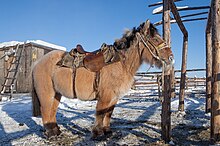| Kuda yakut |
|---|
 |
Kuda yakut (bahasa Sakha: Саха ата, Sakha ata) adalah ras kuda yang langka dari wilayah Republik Sakha (atau Yakutia) di Siberia. Kuda ini cukup besar apabila dibandingkan dengan kuda yang serupa seperti kuda mongolia dan kuda przewalski.[1] Kuda yakut dikenal karena mampu beradaptasi dengan iklim yang sangat dingin di Yakutia, seperti kemampuannya untuk mencari dan memakan tumbuhan yang tersembunyi di bawah lapisan salju,[2] serta kemampuan untuk bertahan di suhu yang mencapai −70 °C (−94 °F).[3]
Kuda ini tampaknya berevolusi dari kuda hasil domestikasi yang dibawa oleh orang Yakut saat mereka pindah ke tempat ini pada permulaan abad ke-13, dan bukan keturunan kuda liar yang menghuni wilayah ini pada zaman Neolitikum.[3]
Catatan kaki
- ^ Breeds of Livestock - Yakut Horse, Department of Animal Science, Oklahoma State University, diakses tanggal 2009-04-20,
... Compared to horses of similar type and Mongolian origin, the Yakut is larger and more massive. Three Yakut types have been formed: the Northern original Yakut (the Middle Kolyma or Verkhoyansk horse); the smaller southern type which was not crossed with improved breeds; and the larger southern type tending towards the breeds used for the improvement of the local Yakut ...
- ^ Anatoly Mikhailovich Khazanov (1995), After the USSR: ethnicity, nationalism and politics in the Commonwealth of Independent States, University of Wisconsin Press, ISBN 0-299-14894-7, diakses tanggal 2009-04-20,
... The Yakut horse has the ability to uncover grass that is under as much as 50 centimeters of snow (and the snow cover lasts in the country for seven to eight months a year) ...
- ^ a b Librado, Pablo; et al. (23 November 2015). "Tracking the origins of Yakutian horses and the genetic basis for their fast adaptation to subarctic environments". Proceedings of the National Academy of Sciences of the United States of America. 112 (50): E6889–97. doi:10.1073/pnas.1513696112. Ringkasan – University of Copenhagen press release (23 November 2015).
contemporary Yakutian horses do not descend from the native horses that populated the region until the mid-Holocene, but were most likely introduced following the migration of the Yakut people a few centuries ago. Thus, they represent one of the fastest cases of adaptation to the extreme temperatures of the Arctic.
Popular science write-ups: siberiantimes.com, bbc.com, equimed.com, phys.org
